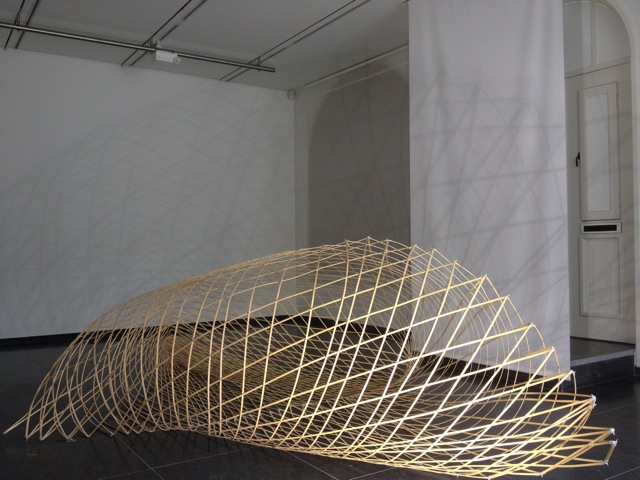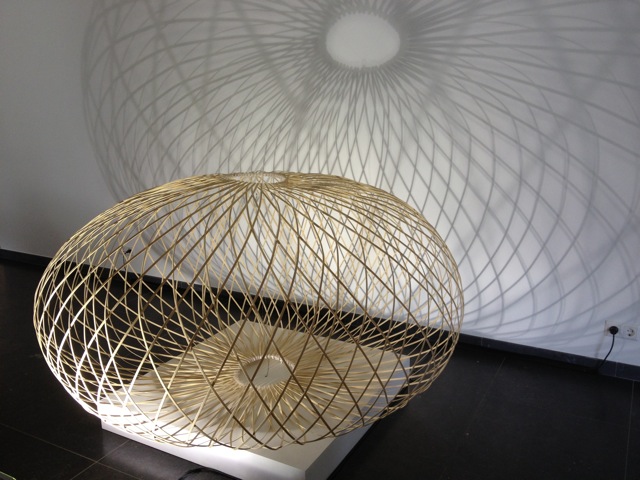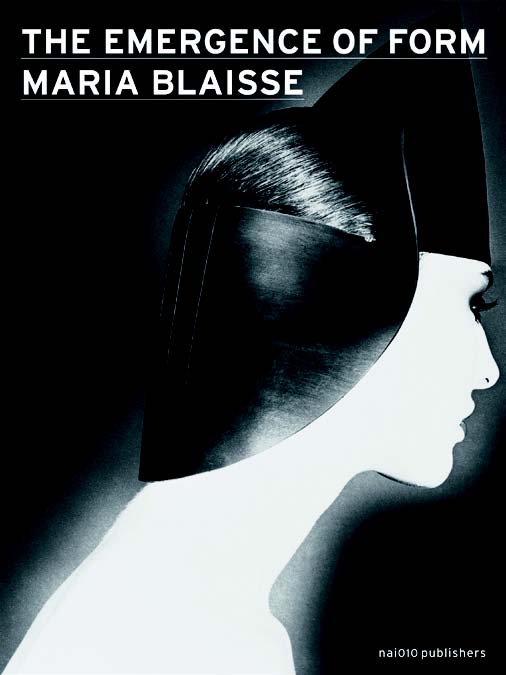Maria Blaisse has set De Ketelfactory in motion. Her large bamboo sculptures breathe, throwing moving shadows across the floors and walls. As a visitor, you feel part of a film. The entire space is alive.
Designer and artist Maria Blaisse has been investigating ‘shapes’ in materials and applications for many years. She has developed a number of large bamboo sculptures over the last few years.
The exhibition at De Ketelfactory includes three such flexible bamboo structures that set the galleries in motion through a play of light and shadow. By the contraction and relaxation of the structures, the works almost act as perpetuum mobiles.
Also being shown along witho these three-dimensional pieces are two short films, in which bamboo structures take centre stage as they interact with people and the elements.
Book presentation
During the opening of the exhibition, the first copy of ‘The Emergence of Form’, which tells about Maria Blaisse’s body of work, will be presented to Oek de Jong, who is giving the opening speech. On the basis of developments within her oeuvre, we see how one form emerges almost organically from the other. From a car tire to hats, theater costumes, glass and mesh forms, and then her current work, the bamboo sculptures: it’s all there. ‘The Emergence of Form’ has been published by nai010 publishers, Rotterdam.
Maria Blaisse
Since graduating from the Gerrit Rietveld Academie, Maria Blaisse has developed her very own language of forms. No matter how varied her work is, Blaisse’s hand remains distinctly recognizable in it.
Her designs are on the cutting edge of art, design, textile and fashion; they find their ways to theaters, museums, art galleries and even to the Paris catwalk.
From her first major project ‘The Big Knot’ to the large and flexible bamboo sculptures made in recent years, movement has played an significant role in the designs of Maria Blaisse.
In the publication accompanying the exhibition, art critic Frits de Coninck says the following about her creative process:
“The outset is both obvious and inimitable. Maria Blaisse takes a piece of rubber, grabs it at both ends, and all at once a form takes shape: a multiply rotated cylinder, not unlike a snail’s shell or a detail from one of Baroque architect Bernini’s gyrating pillars. While a snail and an architect need time, tranquillity and energy to produce such a complex form, Maria Blaisse needs only a single movement to obtain that sculptural image from a chunk of tire rubber. An inner tube: how ordinary can it get? Yet precisely in that humble material lie forces which have unexpected potential. Maria Blaisse recognizes this, because she seeks the energy available in the material. […]”
distillation ‘The Emergence of Form’
Date: 16 June 2013
In collaboration with: Kenzo Kusuda, Joost Swarte, Frank Heckman and Niti Ranjan Biswan
Kenzo Kusuda dances
Holland-based Japanese choreographer/dancer Kenzo Kusuda reveals the poetry of the dancing body in his work. He draws the spectator into a world filled with imagination and mystical beauty. Kenzo Kusuda wrote a choreography for one of Maria Blaisse’s bamboo sculptures. He will perform this choreography during the distillation.
Joost Swarte about the clear line
Joost Swarte is a well-known Dutch cartoon artist and designer. His work distinguishes itself by its great simplicity and clarity. He draws a world without shadows, in which depth is merely suggested though ‘clear lines’. “In my comics, I try to combine the freedom of underground artists with the craftsmanship of the old masters”. He speaks on the links between his work and that of Maria Blaisse.
Frank Heckman on social architecture
Social architect and writer Frank Heckman helps and coaches people, organisations and systems toward renewal and sustainable achievement. He bases his work on a ‘theory of open systems’. He is co-author of several books, including ‘The Hero’s Journey’ which he wrote with Steven de Bie. A recent work is ‘Flow on Stage, the Art of Sustainable Performance’ (2013), a book on the secrets of stage performing. Frank Heckman speaks about his specialism in relation to the works of Maria Blaisse.
Niti Ranjan Biswan
Niti Ranjan Biswas was born in Bangladesh, but lives in Amsterdam. He is a well-known tabla player and percussionist, who expresses tradition and creativity though music. He regularly performs with leading musicians from China, India, the Netherlands and Senegal in the ‘World of Strings’. Niti Ranjan Biswan performs a concert combining tabla and percussion.
video portrait
publication
Maria Blaisse’s bamboo sculptures were made to move – a reason to release a publication on DVD. Recordings include a registration of the sculptures in motion by Gerrit Schreurs and Kim Everdine Zeegers’ video portrait of Maria Blaisse.
Excerpt by Frits de Coninck: “What to call Maria Blaisse’s artistry? Is she a designer or an artist? Is there even a difference in her case? To her, it barely matters, as she pays little heed to the traditional barriers that separate music, art and dance. For her, it all meets and everything she does fits into an exploration of humanity and its natural environment. Specifically, she looks at the energy stored within biodiversity. A concept that saturates all of her work. One may call that her artistic signature. But don’t expect her to make sweeping statements or designs that emanate a specific social engagement. Her work doesn’t talk about energy, it is energy, present in the molecules of matter in her hands, the matter she transforms into new shapes and which always enjoys a subtle harmony with the nature we’ve been given. Modest and extremely precise.” The texts are recorded in English and in Dutch.
order
articles (in Dutch)
La danza della vita – Porzia Bergamasco in Casamica
Een long van bamboe – Peter Henk Steenhuis in Trouw



